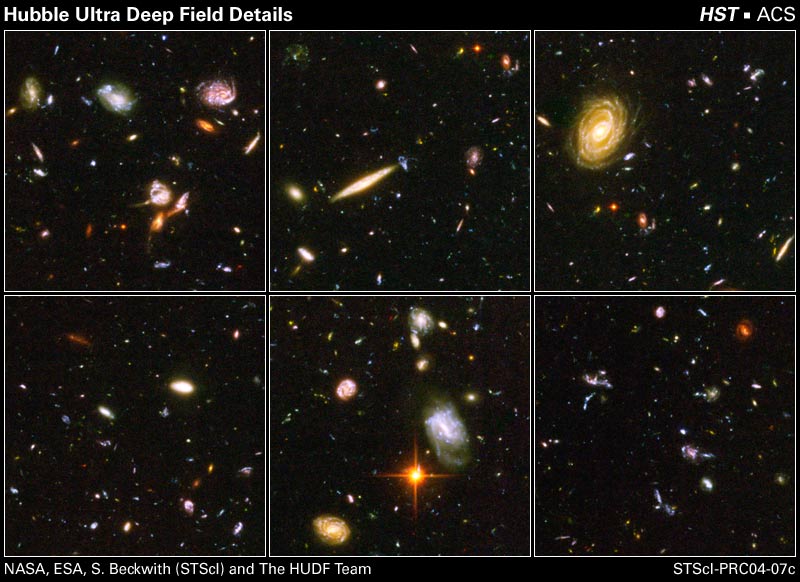
Press Release No.: STScI-2004-07
March 9, 2004
Hubble's Deepest View Ever of the Universe Unveils Earliest Galaxies
Hubble Reveals Galactic Drama
A galactic brawl. A close encounter with a spiral galaxy. Blue wisps of galaxies. These close-up snapshots of galaxies in the Hubble Ultra Deep Field reveal the drama of galactic life.
Almost every panel shows oddball-shaped galaxies engaged in boxing matches with galactic neighbors. In the panel at top, left, three galaxies just below center are enmeshed in battle, their shapes distorted by the brutal encounter. The panel at top, center, reveals an edge-on spiral galaxy fending off a weirdly shaped blue galaxy. The panel at bottom, right, is littered with close encounters between galaxies that have been shredded by the interactions. These oddball galaxies chronicle a period when the universe was younger and more chaotic. Order and structure were just beginning to emerge.
Not all the galaxies are engaged in galactic mayhem. In the panel at top, right, is a majestic spiral galaxy, one of the nearest galaxies in the Ultra Deep Field. This galaxy existed about 1 billion years ago, when the cosmos was 13 billion years old. The smallest, reddest galaxies [the red dots in the panels at top, left and bottom, left] may be among the most distant known, existing when the cosmos was 800 million years old.
The galaxies in these panels were plucked from a harvest of nearly 10,000 galaxies in the Ultra Deep Field, the deepest visible-light image of the cosmos.
The Ultra Deep Field observations, taken by the Advanced Camera for Surveys (ACS), represent a narrow, "deep" view of the cosmos. Peering into the Ultra Deep Field is like looking through an eight-foot-long soda straw.
In ground-based images, the patch of sky in which the galaxies reside (just one-tenth the diameter of the full Moon) is largely empty. Located in the constellation Fornax, the region is so empty, in fact, that only a handful of stars within the Milky Way galaxy can be seen in the image.
In this image, blue and green correspond to colors that can be seen by the human eye, such as hot, young, blue stars and the glow of Sun-like stars in the disks of galaxies. Red represents near-infrared light, which is invisible to the human eye, such as the red glow of dust-enshrouded galaxies.
The image required 800 exposures taken over the course of 400 Hubble orbits around Earth. The total amount of exposure time was 11.3 days, taken between Sept. 24, 2003 and Jan. 16, 2004.
Crédito:NASA, ESA, S. Beckwith (STScI) y el HUDF Team.
TIFF and JPEG images, and press release texts are available via World Wide Web at
Hubble's Deepest View Ever of the Universe Unveils Earliest Galaxies
(HubbleSite - NewsCenter. March 9, 2004)
The Space Telescope Science Institute is operated by the Association of Universities for Research in Astronomy, Inc. (AURA), for NASA,
under contract with the Goddard Space Flight Center, Greenbelt, MD.
The Hubble Space Telescope is a project of international cooperation between NASA and the European Space Agency (ESA).
Updated: March 11 '04
Best seen with MS Internet Explorer.
Back: Observatorio ARVAL - Hubble Ultra Deep Field
Messages: